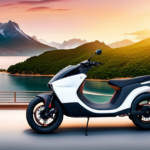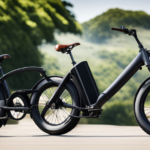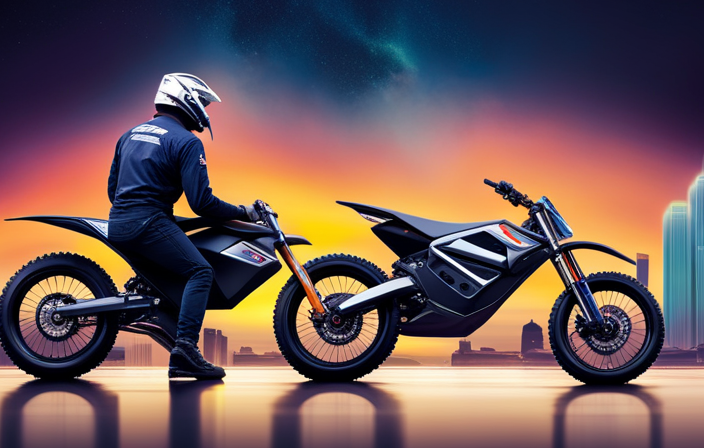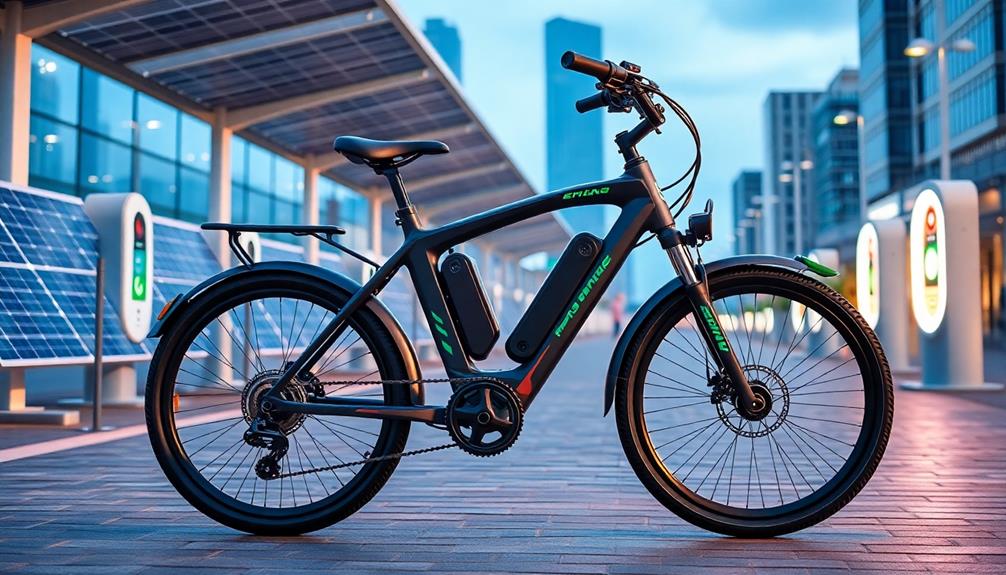Get ready to hit the road with the thrilling freedom of an electric bike. Like a boundless breeze, these two-wheeled wonders offer a unique way to navigate the world.
But, how far can they take you? In this article, we’ll explore the factors that affect electric bike range, tips for maximizing mileage, and the importance of battery life and maintenance.
Join me as we delve into the world of electric bikes and discover just how many miles they can conquer.
Key Takeaways
- Battery capacity is a key factor in determining the range of an electric bike.
- Terrain, rider weight, speed, and pedal assist level also impact the mileage of an electric bike.
- Range extenders, such as gas generators and solar panels, can provide additional power and extend the bike’s range.
- Regular maintenance, including checking battery health and properly maintaining bike components, ensures extended range and optimal performance.
Understanding Electric Bike Range
You’ll need to consider factors like battery capacity and terrain to understand how far an electric bike can go. When estimating the range of an electric bike, it’s important to take into account the battery capacity, as it determines the amount of energy available to power the motor. A higher battery capacity generally means a longer range.
Additionally, the terrain plays a crucial role in determining how far an electric bike can go. Riding on hilly terrain or rough surfaces requires more power, reducing the overall range.
Other factors that affect electric bike mileage include rider weight, speed, and level of pedal assist. By considering these factors, you can get a better understanding of how many miles an electric bike will do.
Moving on to the next section, let’s explore the factors that affect electric bike mileage.
Factors That Affect Electric Bike Mileage
To maximize your electric bike’s mileage, consider factors such as terrain, weight, and battery capacity. These electric bike range factors play a crucial role in determining how far your bike can go on a single charge.
When it comes to terrain, the type of roads or paths you ride on can significantly impact your electric bike mileage. Uphill rides tend to consume more battery power, reducing the overall distance you can cover. Similarly, riding on rough or uneven surfaces requires more effort from the motor, resulting in decreased mileage. On the other hand, flat and smooth terrains allow for more efficient use of the battery, enabling longer rides.
Understanding the impact of terrain on electric bike mileage is essential for planning your routes and managing your battery capacity effectively.
Moving forward to the next section discussing average electric bike mileage, it is important to keep in mind these factors to estimate how far your electric bike can take you.
Average Electric Bike Mileage
When riding an electric bike, it’s important to consider the average mileage you can expect to achieve. Understanding battery capacity is crucial in determining how far you can go on a single charge.
The higher the battery capacity, the longer your electric bike will be able to travel. However, it’s important to note that the mileage can also be influenced by the terrain you ride on. Uphill climbs and rough terrains can significantly impact the electric bike’s mileage, as they require more power from the battery.
On the other hand, riding on flat and smooth surfaces will allow you to achieve a higher mileage. It’s essential to take these factors into account when planning your rides and managing your battery usage. Considering range extenders and additional batteries can help you go even further without needing to recharge.
Range Extenders and Additional Batteries
Consider adding range extenders or extra batteries to increase the distance you can travel on your electric bike without needing to recharge. Range extenders are devices that can be attached to your electric bike to provide additional power and extend the range of your bike. There are several range extender options available, including gas-powered generators and solar panels. Gas-powered generators can provide a continuous source of power, but they can be noisy and emit fumes. Solar panels, on the other hand, are a clean and silent option, but they may not provide as much power as gas generators. Another option is to simply carry an extra battery with you. This can be convenient as you can easily swap out the batteries when one runs out of power. However, additional batteries can add weight to your bike, which can impact its performance. In conclusion, range extenders and additional batteries can significantly increase the distance you can travel on your electric bike. However, it’s important to consider the pros and cons of each option before making a decision. Moving on to tips for maximizing electric bike range…
Tips for Maximizing Electric Bike Range
When it comes to maximizing the range of an electric bike, there are a few key points to keep in mind.
First, it’s important to use pedal assist wisely. By finding the right balance between human power and electric assistance, you can conserve battery life and go further.
Secondly, optimizing tire pressure is crucial for efficiency. Maintaining the recommended tire pressure will reduce rolling resistance and improve the bike’s overall range.
Lastly, riding efficiently by avoiding excessive speed and unnecessary braking will also help to conserve energy and extend the electric bike’s range.
Use Pedal Assist Wisely
Using pedal assist wisely can help increase the mileage of an electric bike. Maximizing efficiency is key when it comes to extending the range of an electric bike. Here are some tips for using pedal assist effectively:
-
Gradually increase the level of assistance: Start with a lower level of pedal assist and gradually increase it as needed. This helps conserve battery power and ensures a longer ride.
-
Use pedal assist on uphill climbs: Pedal assist can be particularly helpful when tackling uphill climbs. It reduces the strain on your legs and allows you to maintain a consistent speed.
-
Combine pedal power with pedal assist: Instead of relying solely on pedal assist, try to combine it with your own pedal power. This helps maximize battery life and allows you to go further.
-
Avoid using pedal assist on flat terrain: On flat terrain, it’s best to rely on your own pedaling power rather than using pedal assist. This helps conserve battery power for when you really need it.
-
Monitor battery management: Keep an eye on your battery level and use pedal assist accordingly. If you notice the battery getting low, decrease the level of assistance to conserve energy.
By following these tips and using pedal assist wisely, you can optimize the mileage of your electric bike.
Next, let’s delve into another important aspect of maximizing range: optimizing tire pressure.
Optimize Tire Pressure
To get the most out of your electric bike, it’s important to optimize the tire pressure. Maximizing battery life and choosing the right tire are crucial factors in achieving optimal performance. By keeping your tire pressure at the recommended level, you can ensure a smoother ride and increase your bike’s efficiency. A properly inflated tire reduces rolling resistance, which means less effort is required to pedal, resulting in longer battery life. To help you understand the impact of tire pressure on your electric bike’s performance, take a look at the table below:
| Tire Pressure (PSI) | Ride Quality | Battery Life |
|---|---|---|
| 30 | Poor | Shortened |
| 40 | Average | Moderate |
| 50 | Excellent | Extended |
By choosing the right tire pressure, you can maximize your electric bike’s battery life and enjoy a comfortable ride. Now, let’s explore how to ride efficiently without compromising performance.
Ride Efficiently
You can increase the efficiency of your ride by adopting efficient riding techniques. Here are four ways to improve your ride efficiency and conserve energy:
-
Pedal smoothly: Avoid sudden and jerky movements while pedaling. Maintain a steady cadence and try to pedal in a circular motion.
-
Use lower gears: When riding uphill or against strong winds, shift to lower gears to make pedaling easier. This will help you conserve energy and ride more efficiently.
-
Reduce drag: Minimize wind resistance by tucking in your elbows and knees, and keeping your body low and streamlined. This can significantly increase your speed and conserve energy.
-
Plan your route: Avoid unnecessary detours and traffic-heavy roads. Plan your route to take advantage of bike paths and avoid stops and starts, which can waste energy.
By implementing these efficient riding techniques, you can maximize your ride efficiency and conserve energy.
Now let’s delve into the range comparison of electric bike models.
Electric Bike Range Comparison by Models
Choose an electric bike model and see how many miles it can go. When comparing electric bike ranges, it is crucial to consider the different models available on the market. Each model has its own battery capacity, motor power, and overall efficiency, which directly affects the distance it can cover on a single charge.
By analyzing electric bike range comparisons, we can not only determine the maximum mileage but also understand the environmental impact of these bikes. Some models can go up to 50 miles on a single charge, while others may only reach 20 miles.
It’s important to note that factors such as terrain, rider weight, and weather conditions can also influence the range. Understanding these differences will help you make an informed decision when selecting an electric bike for your long-distance trips.
Long-Distance Electric Bike Trips
After comparing the electric bike range of different models, it’s time to delve into the realm of long-distance electric bike trips. This topic is particularly intriguing as it allows us to explore the true potential of these eco-friendly rides. When it comes to long-distance journeys, it’s essential to consider the electric bike range and its environmental impact. To provide a comprehensive analysis, let’s take a look at a comparison table showcasing the range of several electric bike models, along with their corresponding environmental impact. This table will help us understand the differences between various models and their efficiency in terms of distance covered and carbon emissions. By understanding these factors, we can make informed decisions about which electric bike is best suited for our long-distance needs. Moving forward, let’s answer some frequently asked questions about electric bike range.
Electric Bike Range FAQ
To understand the range of an electric bike, it’s helpful to explore some frequently asked questions about how far it can go on a single charge. Here are some key factors that can affect the range of an electric bike:
-
Electric bike range vs speed: The faster you ride, the quicker you’ll drain the battery. It’s important to find a balance between speed and range.
-
Electric bike range and weather conditions: Cold weather can reduce battery performance, while hot weather can cause the battery to overheat. Riding in hilly terrain can also impact range.
-
Battery capacity: The size of the battery will determine how far you can travel on a single charge. Larger batteries generally offer longer range.
-
Rider weight: Heavier riders will use more power, which can reduce the overall range.
-
Terrain: Riding on flat roads will allow for longer distances, while off-road or mountainous terrain can shorten the range.
Understanding these factors can help you determine the range of an electric bike and choose the best option for your needs.
Now, let’s move on to discussing electric bikes for commuting.
Electric Bikes for Commuting
When it comes to electric bikes for commuting, two important aspects to consider are calculating commute distance and range, as well as the benefits they offer for daily travel.
By determining the distance of your daily commute, you can gauge whether an electric bike can provide enough range to accommodate your needs.
With their ability to provide assistance when pedaling, electric bikes make commuting easier and more efficient, allowing you to arrive at your destination feeling less fatigued and sweaty.
Additionally, they offer a greener alternative to traditional transportation methods, reducing both carbon emissions and traffic congestion.
Calculating Commute Distance and Range
You can calculate the distance of your commute and determine the range of the electric bike. To do this, you need to know the exact distance you travel to and from work. Use a map or GPS device to measure the distance accurately.
Once you have the distance, you can estimate the range of the electric bike. Keep in mind that the range can vary depending on factors such as terrain, weight, and speed. It’s important to consider these factors when calculating the accuracy of your estimate.
By understanding the range of the electric bike, you can determine if it is suitable for your daily commute.
Now let’s explore the benefits of electric bikes for commuting and how they can improve your daily travels.
Benefits of Electric Bikes for Commuting
When it comes to calculating commute distance and range, it’s important to consider the benefits of electric bikes. As someone who has extensively researched this topic, I can confidently say that electric bikes offer numerous advantages for commuting.
Firstly, they have an impressive range compared to traditional bicycles, allowing you to cover longer distances without getting exhausted.
Secondly, electric bikes have a minimal environmental impact, as they produce zero emissions and contribute less to air pollution compared to cars or motorcycles.
Lastly, electric bikes can help reduce traffic congestion in urban areas, as they are more maneuverable and can easily navigate through crowded streets.
With these benefits in mind, it’s clear why electric bikes are becoming an increasingly popular choice for commuting.
Now, let’s delve into how electric bikes can be enjoyed for leisure and recreation.
Electric Bikes for Leisure and Recreation
Electric bikes are great for leisure and recreation because they can go for many miles. Whether you’re exploring a new city or taking a scenic ride through the countryside, electric bikes provide a fun and convenient way to experience the outdoors.
Many places offer electric bike rentals, allowing you to easily access these bikes for a day of adventure. You can also join electric bike tours, which provide guided rides and the opportunity to discover new routes and attractions.
The long range of electric bikes ensures that you can cover a significant distance without worrying about running out of battery power. In the next section, we will explore the topic of electric bike range and sustainability, highlighting the impressive distances that can be achieved on these eco-friendly vehicles.
Electric Bike Range and Sustainability
The impressive range of electric bikes allows riders to cover significant distances without worrying about running out of battery power. Electric bike range is an important factor to consider when thinking about sustainability and the environmental impact of transportation. With the ability to travel up to 100 miles on a single charge, electric bikes provide a practical solution for commuting and leisure activities. This extended range is made possible by advancements in battery technology and efficient motor systems. Additionally, the growing infrastructure for charging electric bikes makes it even more convenient for riders to travel longer distances without the fear of being stranded. However, it is important to note that electric bike range can vary depending on factors such as terrain, rider weight, and speed. In the next section, we will explore the topic of electric bike battery life and replacement, which is crucial for maintaining the longevity of these sustainable transportation options.
Electric Bike Battery Life and Replacement
When it comes to the lifespan of an electric bike battery, there are several factors that can affect how long it will last. These factors include the type of battery used, how often it is charged, and the overall usage of the bike.
It’s important to consider these factors when deciding on a battery replacement, as the cost and considerations can vary depending on the specific battery model and brand.
Factors Affecting Battery Lifespan
To extend your battery lifespan on an electric bike, you should avoid leaving it in extreme temperatures. Battery charging and battery capacity are two important factors that affect the overall lifespan of the battery.
It is essential to charge your battery properly and avoid overcharging or undercharging it. Overcharging can lead to overheating and reduce the battery’s efficiency over time, while undercharging can negatively impact the battery’s capacity. It is recommended to follow the manufacturer’s guidelines for charging your battery to ensure its longevity.
Additionally, regularly checking the battery’s capacity and avoiding deep discharges can help maintain its lifespan. By taking these steps, you can maximize the lifespan of your electric bike’s battery and ensure optimal performance.
Moving on to the cost and considerations for battery replacement, it is important to note that…
Cost and Considerations for Battery Replacement
If you’re considering replacing your battery, there are important cost and considerations to keep in mind.
Battery cost and battery lifespan are two key factors to consider when deciding whether to replace your electric bike battery. The cost of a new battery can vary depending on the brand and capacity, ranging from $200 to $1000. It’s important to research and compare prices before making a purchase.
Additionally, battery lifespan is another crucial aspect to consider. Most electric bike batteries have a lifespan of 3 to 5 years, but this can be affected by factors such as temperature, usage, and maintenance. Regularly charging and properly storing your battery can help extend its lifespan.
As we move into the subsequent section about electric bike range and safety, it’s important to understand how battery replacement costs and lifespan can impact your overall riding experience.
Electric Bike Range and Safety
When it comes to electric bike range and safety, the importance of range for safety on long rides cannot be overstated. Having a sufficient range ensures that you won’t run out of battery power in the middle of your journey, which can be especially dangerous in remote areas or at night.
To stay safe on electric bike trips, it’s also important to follow basic safety tips. These include wearing a helmet, obeying traffic laws, and staying alert to potential hazards on the road.
Importance of Range for Safety on Long Rides
The range of an electric bike is crucial for ensuring safety on long rides. When embarking on a lengthy journey, it is essential to have confidence in the bike’s ability to cover the distance without running out of power.
The importance of range for safety on long rides cannot be overstated. Electric bikes offer numerous benefits for commuting, including reduced carbon emissions and cost savings. However, on longer trips, the range becomes even more significant.
Knowing that your electric bike can handle the distance gives you peace of mind and eliminates the risk of being stranded in unfamiliar territory.
In the next section, we will discuss tips for staying safe on electric bike trips, providing you with valuable insights to enhance your riding experience without compromising your well-being.
Tips for Staying Safe on Electric Bike Trips
Here are some tips to ensure your safety on electric bike trips.
First and foremost, staying hydrated is crucial. Electric bikes may make riding easier, but it’s still important to drink plenty of water to avoid dehydration, especially on longer rides.
Additionally, make sure your helmet fits properly. A properly fitted helmet is essential for protecting your head in case of an accident. Adjust the straps and ensure a snug fit to keep your head safe.
Lastly, always be aware of your surroundings and follow traffic rules. Stay alert and use hand signals to communicate with other riders and drivers.
By following these tips, you can have a safe and enjoyable electric bike trip.
Speaking of safety, let’s now discuss electric bike range and maintenance.
Electric Bike Range and Maintenance
To figure out how far you can go on an electric bike, you’ll need to consider its range and perform regular maintenance. Electric bike range optimization is crucial for maximizing your travel distance. Factors such as terrain, rider weight, and speed can affect the range of your electric bike. To get the most out of your battery, try to ride on flat surfaces and avoid excessive acceleration. Troubleshooting electric bike performance is also important. Regularly check your tire pressure, chain tension, and brakes to ensure optimal performance. Additionally, keeping your battery charged and avoiding extreme temperatures can help extend its lifespan. By taking these steps, you can ensure that your electric bike will take you on many miles of enjoyable rides. Embrace the freedom of electric bike travel and explore new horizons.
Conclusion: Embrace the Freedom of Electric Bike Travel
Embrace the freedom of electric bike travel and explore new horizons by taking advantage of the range optimization and maintenance tips provided.
Electric bikes offer an incredible range for both off-road adventures and urban commuting. Whether you’re looking to tackle rugged terrains or navigate through city streets, electric bikes have got you covered. With their advanced battery technology and efficient motors, these bikes can go the distance.
For off-road adventures, electric bikes can cover up to 50 miles on a single charge, allowing you to explore remote trails and enjoy nature’s beauty. In urban areas, electric bikes can easily cover 20-30 miles, making them a convenient and eco-friendly mode of transportation.
By investing in regular maintenance and optimizing your electric bike’s range, you can truly embrace the freedom of electric bike travel and discover new horizons.
Frequently Asked Questions
Are electric bikes more expensive to maintain than traditional bikes?
Yes, electric bikes are generally more expensive to maintain than traditional bikes. The electric components, such as the battery and motor, require regular servicing and replacement, which can add to the maintenance costs.
Can electric bikes be charged using a regular household outlet?
Yes, electric bikes can be charged using a regular household outlet. This is one of the advantages of electric bike charging options. It provides convenience and accessibility for riders, allowing them to easily charge their bikes at home.
How long does it typically take to fully charge an electric bike battery?
Charging an electric bike battery typically takes a few hours, depending on the charging speed and various factors. Factors include battery capacity, charging method, and the power output of the charger.
Are there any limitations to riding an electric bike in extreme weather conditions?
There are limitations to riding an electric bike in extreme weather conditions. Harsh temperatures can negatively affect battery performance, reducing the bike’s range and overall efficiency. It’s important to consider weather conditions when planning your electric bike rides.
Can the range of an electric bike be affected by the rider’s weight?
Like a feather on a breeze, the rider’s weight impacts an electric bike’s range. The correlation lies in the battery life, as a heavier rider requires more power, reducing the distance the bike can travel.
Conclusion
In conclusion, the electric bike revolution has brought forth a new era of freedom in travel. Electric bikes offer a convenient and eco-friendly mode of transportation, with an average mileage of around 40-50 miles. By considering factors such as terrain, rider weight, and battery capacity, one can maximize the range of their electric bike. Range extenders and extra batteries can provide even more mileage. Just like a breeze that knows no boundaries, electric bikes empower riders to explore the world with ease and joy.

















